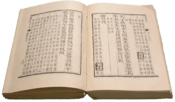Ode facts for kids
| Literature |
|---|
 |
| Major forms |
| Genres |
| Media |
|
| Techniques |
| History and lists |
|
| Discussion |
|
An ode is a special type of poem that comes from Ancient Greece. It's a lyric poem, which means it expresses strong feelings and thoughts. Odes are usually written to praise or celebrate something important. This could be an event, a person, or even nature itself.
Imagine a song without music, but with very powerful words. That's a bit like an ode! In ancient times, Greek odes were often performed with music. People would use instruments like the aulos (a type of flute) or the lyre (a stringed instrument). Over time, odes became more about personal feelings and could be recited or sung.
There are three main kinds of odes:
- The Pindaric ode
- The Horatian ode
- The irregular ode
Each type has its own special rules for how it's put together. Odes use rich and imaginative language to share deep and sincere emotions.
Contents
What is an Ode?
An ode is a type of lyric poetry. It is usually a long poem that expresses strong feelings. Odes often celebrate or honor a person, place, thing, or idea. They are known for their formal style and beautiful language.
Different Kinds of Odes
Odes have changed over time, leading to different styles. The main types are named after famous ancient poets.
Pindaric Odes
Pindaric odes are also called Greek odes. They follow the style of the ancient Greek poet Pindar. These odes have a special three-part structure:
- The strophe
- The antistrophe
- The epode
In Ancient Greece, these odes were performed on a stage. The performers would sing or recite the strophe while moving to one side of the stage. Then, they would move to the other side for the antistrophe. Finally, they would go to the center for the epode.
This movement shows how the ode is built:
- The strophe introduces a main idea or theme.
- The antistrophe offers a different or balancing viewpoint.
- The epode then brings everything together, like a summary.
Pindaric odes don't always have a strict rhyme or line length. However, the strophe and antistrophe usually have the same structure. The epode often has a different form.
Famous examples include William Wordsworth's Ode on Intimations of Immortality (1807). Also, Thomas Gray's The Progress of Poesy: A Pindaric Ode (1757) is a good example. Gray's The Bard: A Pindaric Ode (1757) repeats the three-part structure three times. This makes it a longer poem with nine stanzas.
Horatian Odes
Horatian odes are named after the Roman poet Horace. They are sometimes called homostrophic odes. Unlike Pindaric odes, Horatian odes have many stanzas. All these stanzas usually follow the same rhyme scheme and rhythm.
Horatian odes are often more personal than Pindaric odes. They talk about subjects like love and friendship. They were not usually written for public performances.
Some of the most famous Horatian odes were written by the English poet John Keats. His Ode to a Nightingale (1819) is a very well-known example.
Irregular Odes
Irregular odes are the most flexible type. They don't follow the strict rules of Pindaric or Horatian odes. They are sometimes called Cowleyan odes. This name comes from the English poet Abraham Cowley. He brought this style back in England in 1656.
Cowley's odes often used an iambic rhythm. However, they did not have a regular rhyme or line length. This made them very different from the formal Pindaric odes.
English Odes
The first odes in the English language were written by Edmund Spenser. These were called Epithalamium and Prothalamium.
In the 1600s, Abraham Cowley wrote many odes. His "Pindariques" were popular, even though they misunderstood Pindar's original style. Other poets, like John Dryden, copied Cowley's flexible style.
Later, in the 1700s, people understood Pindar's original metre better. The fashion for Cowley's "Pindariques" faded. However, Thomas Gray wrote true Pindaric odes like The Progress of Poesy and The Bard.
Around 1800, William Wordsworth used Cowley's style for his famous poem, the Intimations of Immortality. Here's a small part of it:
There was a time when meadow, grove, and stream,
The earth, and every common sight,
To me did seem
Apparelled in celestial light,
The glory and the freshness of a dream.
It is not now as it hath been of yore;—
Turn wheresoe'er I may,
By night or day,
The things which I have seen I now can see no more....
Our birth is but a sleep and a forgetting:
The Soul that rises with us, our life's Star,
Hath had elsewhere its setting,
And cometh from afar:
Not in entire forgetfulness,
And not in utter nakedness,
But trailing clouds of glory do we come
From God, who is our home...
Other poets also wrote odes with regular stanza patterns. These included Samuel Taylor Coleridge and Percy Bysshe Shelley. Shelley's Ode to the West Wind is a major poem in this form.
Perhaps the most important odes of the 1800s were Keats's Five Great Odes of 1819. These included:
- "Ode to a Nightingale"
- "Ode on Melancholy"
- "Ode on a Grecian Urn"
- "Ode to Psyche"
- "To Autumn"
After Keats, fewer major odes were written in English. One important exception is the fourth verse of For the Fallen by Laurence Binyon. This part is often called The Ode.
W.H. Auden also wrote an important poem called Ode. It showed his feelings about people not understanding the reality of war.
Sometimes, English odes were set to music. Composers like Purcell, Händel, and Boyce created music for them.
Notable Poets Who Wrote Odes
See also
 In Spanish: Oda para niños
In Spanish: Oda para niños
- Epinikion

